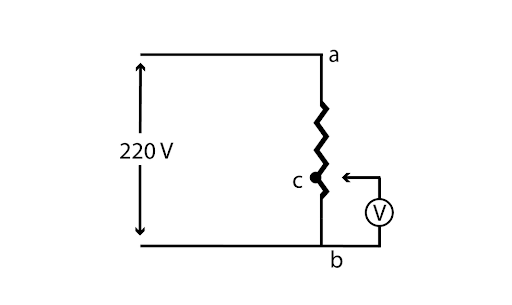
A potential difference of 220 V is maintained across a 12000 ohm rheostat, as shown in the figure. The voltmeter has a resistance of 6000 ohm and point c is at one-fourth of the distance from a to b, therefore, the reading of the voltmeter will be

A. 32 V
B. 36 V
C. 40 V
D. 42 V
Answer
218.7k+ views
Hint:This problem is from the section current electricity. The concept of equivalent resistance is needed to solve this problem. The current decreases as resistance increases. On the other hand, the current increases as the resistance decreases.
Formula used:
Equivalent resistance for a series resistance circuit:
${R_s} = {R_1} + {R_2} + {R_3}$
Where ${R_s}$= series equivalent resistance and ${R_1},{R_2},{R_3}$ = component resistance.
Equivalent resistance for a parallel resistance circuit:
$\dfrac{1}{{{R_p}}} = \dfrac{1}{{{R_1}}} + \dfrac{1}{{{R_2}}} + \dfrac{1}{{{R_3}}}$
Where ${R_p}$= parallel equivalent resistance and ${R_1},{R_2},{R_3}$ = component resistance.
Complete step by step solution:
In the case of linear Rheostat, Resistance (R) is directly proportional to length (L).
$R \propto L$
Then, ${R_{ac}} \propto ac$ and ${R_{ab}} \propto ab$.
Taking the ratio in the values and we will get
$\dfrac{{{R_{ac}}}}{{{R_{ab}}}} = \dfrac{{ac}}{{ab}}$
The given value is:
${R_{ab}} = 12000\Omega $
And, $ac = \dfrac{1}{4}ab \Rightarrow \dfrac{{ac}}{{ab}} = \dfrac{1}{4}$
Substitute these values and find ${R_{ac}}$.
${R_{ac}} = 12000 \times \dfrac{1}{4} = 3000\Omega $
The resistance${R_{ac}}$ is in parallel with the voltmeter. The resistance of the voltmeter is given and that is ${V_R} = 6000\Omega $.
The resistances ${R_{ac}}$ and ${V_R}$ are in parallel connection. Then, the effective resistance between points a and c is,
${R'_{ac}} = \dfrac{{{R_{ac}} \times {V_R}}}{{{R_{ac}} + {V_R}}} \\
\Rightarrow {R'_{ac}} = \dfrac{{3000 \times 6000}}{{9000}} \\
\Rightarrow {R'_{ac}} = 2000\Omega \\ $
The resistance between points a and c is,
${R_{bc}} = 12000 - 3000 = 9000\Omega $.
${R_{bc}}$ and ${R'_{ac}}$ care in series.
Therefore the Voltmeter reading will be,
${V_{ac}} = \dfrac{{{{R'}_{ac}} \times {V_{ab}}}}{{{{R'}_{ac}} + {R_{bc}}}} \\
\therefore {V_{ac}} = \dfrac{{2000 \times 220}}{{9000 + 2000}} = 40V$
Hence, the correct option is option C.
Note: A conductor's electrical resistance is affected by the following parameters: The conductor's cross-sectional area, the conductor's length, the conductor's material and the conducting material's temperature. Electrical resistance is inversely proportional to the cross-sectional area and directly proportional to the conductor's length.
Formula used:
Equivalent resistance for a series resistance circuit:
${R_s} = {R_1} + {R_2} + {R_3}$
Where ${R_s}$= series equivalent resistance and ${R_1},{R_2},{R_3}$ = component resistance.
Equivalent resistance for a parallel resistance circuit:
$\dfrac{1}{{{R_p}}} = \dfrac{1}{{{R_1}}} + \dfrac{1}{{{R_2}}} + \dfrac{1}{{{R_3}}}$
Where ${R_p}$= parallel equivalent resistance and ${R_1},{R_2},{R_3}$ = component resistance.
Complete step by step solution:
In the case of linear Rheostat, Resistance (R) is directly proportional to length (L).
$R \propto L$
Then, ${R_{ac}} \propto ac$ and ${R_{ab}} \propto ab$.
Taking the ratio in the values and we will get
$\dfrac{{{R_{ac}}}}{{{R_{ab}}}} = \dfrac{{ac}}{{ab}}$
The given value is:
${R_{ab}} = 12000\Omega $
And, $ac = \dfrac{1}{4}ab \Rightarrow \dfrac{{ac}}{{ab}} = \dfrac{1}{4}$
Substitute these values and find ${R_{ac}}$.
${R_{ac}} = 12000 \times \dfrac{1}{4} = 3000\Omega $
The resistance${R_{ac}}$ is in parallel with the voltmeter. The resistance of the voltmeter is given and that is ${V_R} = 6000\Omega $.
The resistances ${R_{ac}}$ and ${V_R}$ are in parallel connection. Then, the effective resistance between points a and c is,
${R'_{ac}} = \dfrac{{{R_{ac}} \times {V_R}}}{{{R_{ac}} + {V_R}}} \\
\Rightarrow {R'_{ac}} = \dfrac{{3000 \times 6000}}{{9000}} \\
\Rightarrow {R'_{ac}} = 2000\Omega \\ $
The resistance between points a and c is,
${R_{bc}} = 12000 - 3000 = 9000\Omega $.
${R_{bc}}$ and ${R'_{ac}}$ care in series.
Therefore the Voltmeter reading will be,
${V_{ac}} = \dfrac{{{{R'}_{ac}} \times {V_{ab}}}}{{{{R'}_{ac}} + {R_{bc}}}} \\
\therefore {V_{ac}} = \dfrac{{2000 \times 220}}{{9000 + 2000}} = 40V$
Hence, the correct option is option C.
Note: A conductor's electrical resistance is affected by the following parameters: The conductor's cross-sectional area, the conductor's length, the conductor's material and the conducting material's temperature. Electrical resistance is inversely proportional to the cross-sectional area and directly proportional to the conductor's length.
Recently Updated Pages
A square frame of side 10 cm and a long straight wire class 12 physics JEE_Main

The work done in slowly moving an electron of charge class 12 physics JEE_Main

Two identical charged spheres suspended from a common class 12 physics JEE_Main

According to Bohrs theory the timeaveraged magnetic class 12 physics JEE_Main

ill in the blanks Pure tungsten has A Low resistivity class 12 physics JEE_Main

The value of the resistor RS needed in the DC voltage class 12 physics JEE_Main

Trending doubts
JEE Main 2026: Application Form Open, Exam Dates, Syllabus, Eligibility & Question Papers

Understanding Uniform Acceleration in Physics

Derivation of Equation of Trajectory Explained for Students

Hybridisation in Chemistry – Concept, Types & Applications

Understanding the Angle of Deviation in a Prism

Understanding Collisions: Types and Examples for Students

Other Pages
JEE Advanced Marks vs Ranks 2025: Understanding Category-wise Qualifying Marks and Previous Year Cut-offs

Understanding Atomic Structure for Beginners

How to Convert a Galvanometer into an Ammeter or Voltmeter

Understanding Centrifugal Force in Physics

JEE Main Marking Scheme 2026- Paper-Wise Marks Distribution and Negative Marking Details

Degree of Dissociation: Meaning, Formula, Calculation & Uses




